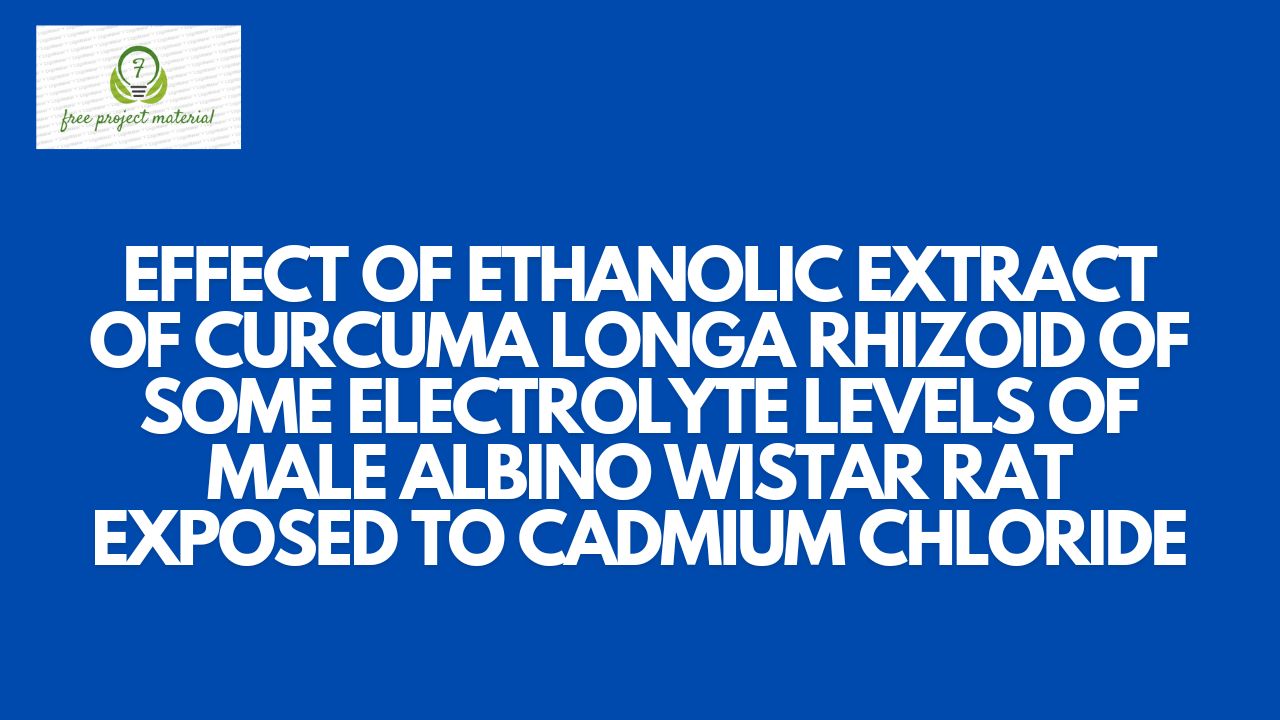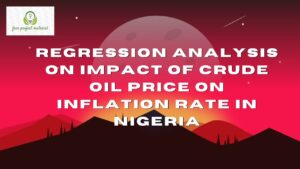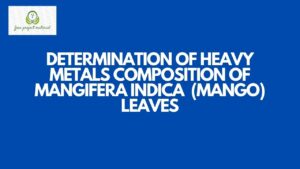ABSTRACT
Medicinal plants have been wisely explored and employed in therapy and treatment of various health conditions. The aim of this study was to investigate the effect of ethanolic extract of turmeric (curcuma longa) rhizoid on some electrolyte of male albino wister rats exposed to cadmium chloride. The research made use of 20male albino wistar rats that were divided into five (5) groups with four (4) rats in each group. Group 1 was the control given rat pellet only, group 2 was given cadmium chloride in addition to normal rat pellet, groups3-5 were given the extract at the concentration of 100mg/kg body weight, 200mg/kg and 300mg/kg body weight respectively after administration of cadmium chloride. The result revealed that there was significant increase (p<0.05) with the serum potassium level groups 3 when compared to group 2, the result also revealed a non-significant decrease (p>0.05) in group 2 compared to group 1 and the treated groups. The result further revealed that curcuma longa showed some ameliorative potential towards the electrolyte alteration caused by cadmium chloride, but these activities were not statistically significant. It is therefore recommended that exposure sources of cadmium be totally minimize and if possible eradicated because of it level of toxicity and curcuma longa be in concluded in meal in order to enjoy not only the nutritional benefit but also the therapeutic benefits. TABLE OF CONTENTS TITLE PAGE- – – – – – – – – i CERTIFICATION- – – – – – – – ii DEDICATION- – – – – – – – – iii ACKNOWLEDGEMENT- – – – – – – iv ABSTRACT- – – – – – – – – v TABLE OF CONTENTS- – – – – – – vi-viii CHAPTER ONE: INTRODUCTION- – – – – – Description of Cucuma Longa– – – – – – — 2.1Origin and Distribution of Cucuma Longa- – – – 2.2 Nutritional/Phytochemistry of Cucuma Longa 2.3 Health benefits of Cucuma Longa- – – – – 2.4 Traditional uses of Cucuma Longa- – – – – 2.5 Physiological importance and Biochemical Roles of Electrolytes- – – – – – – – – – – 2.6 Electrolyte imbalance and effects- – – – – 2.7 Disturbance in fluid and Electrolytes disorder- – – 2.7.1 Diagnosis and Treatment of Electrolyte balance- – – 2.8 Toxicity of heavy metals- – – – – – 2.8.1 Cadmium chloride- – – – – – – 2.9 Electrolytes- – – – – – – – – 2.9.1 Types of Electrolytes in the body- – – – – 2.9.2 Sodium- – – – – – – – – 2.9.3 Calcium- – – – – – – – – 2.9.4 Potassium- – – – – – – – – 2.9.5 Chloride- – – – – – – – – 2.9.6 Bicarbonate- – – – – – – – CHAPTER THREE: MATERIALS AND METHOD 3.1 Materials- – – – – – – – – 3.1.1 Purchase of heavy metals and preservation- – – – 3.1.2 Experimental Design, grouping and treatment- – – 3.1.3 Collection and preservation of blood sample- – – 3.2 Methods- – – – – – – – – 3.2.1 Determination of sodium- – – – – – 3.2.2 Determination of potassium- – – – – – 3.2.3 Determination of calcium- – – – – – 3.2.4 Determination of chloride- – – – – – 3.3.5 Determination of Bicarbonate- – – – – – 3.3 Statistical Analysis- – – – – – – CHAPTER FOUR: RESULTS AND DISCUSSIONS 4.1 Results- – – – – – – – – 4.2 Discussion- – – – – – – – – CHAPTER FIVE: CONCLUSION AND RECOMMENDATIONS 5.1 Conclusion- – – – – – – – – 5.2 Recommendation- – – – – – – – References CHAPTER ONE: INTRODUCTION 1.1 Background of the study Curcuma Longa is a plant medicinal plant that botanically belongs to zingiberacea family (Chattopadhyan et al., 2004). Curcuma Longa is widely used as spice and colouring agent and is known for its medicinal properties (Luthra et al., 2001). Components of Curcuma Longa are named curcuminoids which include mainly curcumin (diferuloylmethane, demethoxycurcumin, and bismethoxy curcumin) (Chainani, 2003). Curcumin is the important fraction which is responsible for the biological activities of turmeric. The melting point of curcumin, (C2H52006) is 184.20C. It is soluble in ethanol and acetone but in soluble in water (Joe et al., 2004). Curcumin, a potent antioxidant is believed to be the most bioactive and soothing portion of the herb turmeric and posses the antioxidant, anti-inflammatory, anti-platelet, cholesterol lowering antibacterial and antifungal effects (Peter, 2000). Moreover, nutrient found in Curcuma Longa do more than just prevent deficiency diseases. It has a high nutritional status that can be exploited. The curcumin contain vitamins or vitamin precursor which produces vitamin C, beta-carotene as well as polyphenol coupled with fatty acid and essential oil. Turmeric is a good source of spice compared with other spices. Thought consumed in Africa and sub-Saharan countries, it has been regarded as an under exploited spice. It has probably been one of the most underutilized tropical crops. The leaves are known as great source of vitamin and minerals (Chattopadhyan et al., 2004). Introduction of the plant as part of diet has been successful despite the fact that new foods are very often difficult to introduce (Henry, 1995). Curcuma Longa has been used traditionally as household remedy in curing various diseases such as anorexia, cough, rheumatism and intestine disorder. There is a need to investigate turmeric scientifically so that it would not be used only traditionally but industrially in food and drug production. This study give an insight of the nutritional, phytochemical and microbial properties of turmeric plant which could be a gate way to different ways in which turmeric could be used. The objectives of this work are to determine the proximate, vitamin, phytochemical and mineral compositions of turmeric plant and to determine the antimicrobial activities of turmeric plant. The rhizome juice from curcuma longa is used in the treatment many diseases such as anthelmintic, asthma, gonorrhea and urinary and its essential oil is used in the treatment of carminative, stomachic and tonic (Phanswan, 2007). In traditional medicine, several plants and herbs have been used experimentally to treat liver disorders, including liver cirrhosis, (Alshawsh et al., 2011), (Kadir et al., 2011). Curcuma longa possesses antioxidant (Maizura et al., 2011), anti-tumor (Kunnumkkara et al., 2007), anti-microbial (Kim et al., 2005), anti-inflammatory (Kohli et al., 2005), wound healing (Panchatcharam et al., 2006), and gastro protective activities (Miriyala et al., 2007). Cirrhosis is the damage of liver cells and their gradual replacement with scar tissue that impairs blood flow through the liver causing hepatocyte death and loss of liver function. It has become obvious that humans have adjusted the global cycle of heavy metals and metalloids, including the toxic non-essential like cadmium. Thus there is enough opportunity for exposure to cadmium both inside and outside the workplace (Vinoth et al., 2010). Cadmium is one of the toxic heavy metals that increased concentration of cadmium in agricultural soils and is come from application of phosphate fertilizers, sewage sludge, waste water, and pesticides (Limei et al., 2008). Further source of cadmium drawn from mining at mines, smelting of ores, and industrial application of cadmium (cd) in pigments, plastic stabilizers, and nickel cadmium batteries resulted in widespread agricultural soil pollution (Liao et al., 2005). Cadmium is a risk reason for humans. It a masses in the body tissue, such as the liver, lungs, kidney, bones, and reproductive organs reported that cadmium creates reactive oxygen species (ROS) causing oxidative damage in various tissues (Liu et al., 2008). It is shown that exposure to cadmium by different routes causes increased lipid peroxidation (LPO) in membranes of erythrocytes and tissues, where thiobarbituric acid reactive substances (TBARS) and hydroperoxides are signs of oxidative damages (Swarup et al., 2007). Intakes of cadmium indicate the use of glutathione (GSH) and protein binding sulfhydryl groups and thus improves the radical, such as hydrogen peroxide, hydroxide and superoxide anions. The liver and kidney are the most vulnerable organs to cadmium toxicity (Ognjanovic et al., 2010). An increase in the levels of serum hepatic marker enzymes, such as aspartate aminotransferase (AST) and alanine transaminase (ALT) following cadmium exposure, suggests the damaging effect of cadmium on the liver in various studies. Human exposed to cadmium occurs chiefly through inhalation or injection. Ten or fifty percent of inhaled cadmium dust is absorbed, depending on particle size. Absorption through skin contact is negligible. About five to ten percent of ingested cadmium is absorbed, also depending on particle size. Intestinal absorption is greater in persons with iron, calcium or zinc deficiency (G. Nordberg et al., 2007). 1.2 Aim and Objectives of the study 1.2.1 Aim of the study The aim of this research was to investigate the effects of ethanolic extract of turmeric (curcuma longa) rhizoid of some electrolyte levels of male wistar rats exposed to cadmium chloride. 1.2.2 Objective of the study The following were the objectives of this study;- To determine the effect of c curcuma longa rhizoid on Calcium levels of male albino wistar rats exposed to cadmium chloride.
- To determine the effect of curcuma longa rhizoid on Potassium levels of male albino wistar rats exposed to cadmium chloride.
- To determine the effect of curcuma longa rhizoid on Sodium levels of male albino wistar rats exposed to cadmium chloride.
- To determine the effect of curcuma longa rhizoid on Chloride levels of male albino wistar rats exposed to cadmium chloride.
- To determine the effect of curcuma longa rhizoid on Bicarbonate levels of male albino wistar rats exposed to cadmium chloride.



